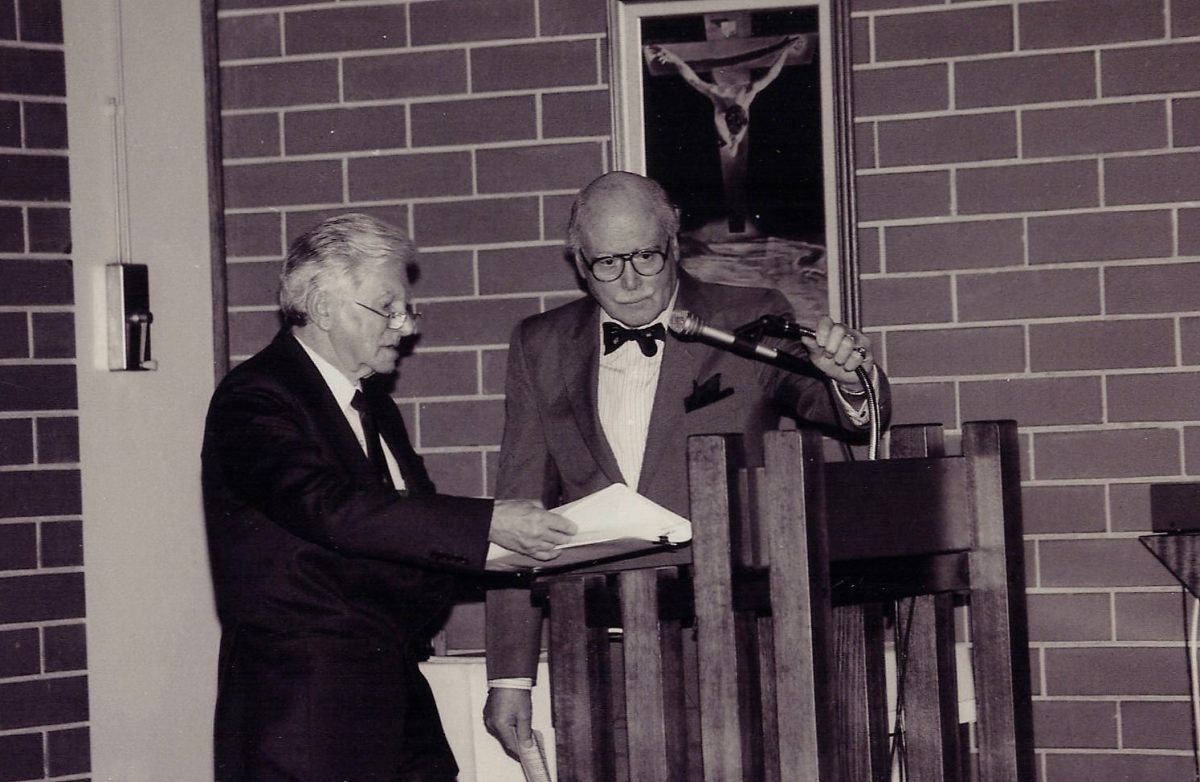Hugh Robert Gilmore MB BS(Adel) FRCP FRACP, Emeritus Physician, Royal Adelaide Hospital
Written by Bernard Nicholson (1993) for The True Glory Publication of Royal Adelaide Hospital Foundation Day Addresses 1979-1993.

Dr Gilmore was born in Adelaide (1921) and educated at Scotch College (1934-38) and the University of Adelaide (1939-45). He contracted tuberculous pleurisy while a fifth-year medical student resulting in six months loss of time whilst recovering this threat to his health. However, this experience gave him an invaluable insight in the management of patients suffering from serious disease. Because of this brush with disease, he was thought not a safe risk to become immediately a Resident Medical Officer after qualifying (1945).
He became the one and only Clinical Pathologist (1945) liaising between Royal Adelaide Hospital and the Institute of Medical and Veterinary Science followed by a year as Resident Medical Officer, Royal Adelaide Hospital (1946).
After working in general practice in Murray Bridge, being consecutively locum tenens (1947) for the late Dr Hugh Wickens and Dr Fred Heddle, he was appointed Resident Medical Officer, The Adelaide Children’s Hospital (1947) and subsequently Assistant Medical Superintendent and Physician, The Broken Hill and District Hospital (1947-1949).
Dr Gilmore married Jeanette Paterson (1947) when a self contained flat and an increased salary at the hospital made such a step possible. While at Broken Hill, and enthralled by the richness of clinical experience in that hospital, he passed his examination for the membership of the Royal Australasian College of Physicians (1948). He was fortunate, after leaving this rich experience and very agreeable lifestyle, to become Assistant to the Director of Medical Studies, University of Adelaide, Dr KS Hetzel, and also as Registrar to Dr Hetzel, Honorary Physician, Royal Adelaide Hospital (1949).
Dr Gilmore was appointed Registrar, Postgraduate Medical School, Hammersmith (1950), in the late Dr Cuthbert Cope’s unit and subsequently Registrar and tutor (1950, 1952) to the Professorial Medical Unit, working with Professor Sir John MacMichael and Professor John Goodwin. During this period he passed his membership of the Royal College of Physicians London (1950.)
He was Senior, then Chief Registrar (1953), The National Heart Hospital, London and returned to South Australia as the foundation Senior Lecturer, Department of Medicine, University of Adelaide, and Honorary Assistant Physician, Royal Adelaide Hospital (1954-58). He helped in the establishment of the medical professorial unit under the headship of the foundation Professor Hugh Norwood Robson (1953-65), affectionately known to us all as Norrie.
There was very little cardiac surgical treatment in 1954, barring an occasional patent ductus arteriosis ligation. It was the very considerable pool of uninvestigated and untreated congenital heart disease as well as a similar large pool of valvular heart disease awaiting investigation and treatment which predicated the formal development of cardiac surgery in South Australia (1958).
The Adelaide Children’s Hospital recognised Dr Gilmore as the cardiologist of that hospital (1968) until the demands of adult medicine dominated his consultative work.
Dr Gilmore introduced modern techniques of cardiac investigation to South Australia, and, undertook duties on a single handed bases, and to use his own expression, as chief cook and bottle washer in cardiac catheterization, angiography6 and phono-cardiography, with such casual assistance as he could muster around Royal Adelaide Hospital. He was glad to share this work with Dr Peter Hetzel when he returned from the Mayo Clinic (1958).
He was Visiting Physician Specialist, Repatriation General Hospital, Springbank and was appointed Honorary Assistant Physician (1958-1964), Honorary Physician (1964) and Senior Visiting Physician (1971), Head of Unit, Royal Adelaide Hospital (1964-1986) until his retirement (1986).
By choosing to remain a physician in general medicine, he felt he was in the best position to continue teaching medical students and perhaps in hindsight, maybe erroneously, believed he was in a better position to practice his own specialty, cardiology, for which he had a very substantial training, along with the other branches of medicine. He continued however to have close links with the cardiac department and was pleased to be, a ‘devil’s advocate’ at the Friday morning clinical meetings previewing patients for cardio-surgical intervention.
As Pfizer travelling Fellow, he attended the World Congress in Cardiology in Mexico City (1960) and thereafter spent five months travelling to major centres in the USA and Great Britain.
Dr Gilmore was a member of the executive of the honorary medical staff at Royal Adelaide Hospital, subsequently The Medical Staff Society. He became its Chairman in 1979. He became a member of the Heritage and History Committee, royal Adelaide Hospital (1990) and attends on a regular basis.
He regrets his family saw so little of him during his busy professional life when he had but a small amount of time to spend with his five children. Now that the tyranny of medicine is no longer in charger, his interests include reading on a very wide bases, a passionate interest in music, musicology and gardening, the latter leading to more frustration than success. For a time he had a large collection of native Australian finches which he successfully bred.
Chess, played mostly against a computer, is an abiding interest as is letter writing to five children and thirteen grandchildren scattered about Australia and New Zealand.
Hugh Gilmore died 26 December 2003